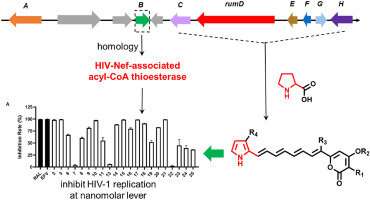The authors reconstituted the biosynthesis of rumbrins, identified a new starter unit of PKS, and obtained 9 rumbrin analogues. Guided by rumB, rumbrins were predicted and pharmacologically demonstrated as anti-HIV agents. Credit: Compuscript Ltd
In a new article from Acta Pharmaceutica Sinica B, authors Beifen Zhong, Jun Wan and colleagues from the Chinese Academy of Medical Sciences & Peking Union Medical College, Beijing, China, discuss biosynthesis of rumbrins and inspiration for discovery of HIV inhibitors.
Investigation on how nature produces natural compounds with chemical and biological diversity at the genetic level offers inspiration for the discovery of new natural products and even their biological targets.
The polyketide rumbrin is a lipid peroxide production and calcium accumulation inhibitor, which contains a chlorinated pyrrole moiety that is a rare chemical feature in fungal natural products.
The authors of this article identify the biosynthetic gene cluster (BGC) rum of rumbrin and its isomer 12E-rumbrin from Auxarthron umbrinum DSM3193, and elucidate their biosynthetic pathway based on heterologous expression, chemical complementation, and isotopic labeling. It is demonstrated that rumbrins are assembled by a highly reducing polyketide synthase (HRPKS) that uniquely incorporate a proline-derived pyrrolyl-CoA starer unit and followed by methylation and chlorination. Sequent precursor-directed biosynthesis was able to yield a group of rumbrin analogs.
Inspired by the presence of a human immunodeficiency virus (HIV)-Nef-associated gene in the rum cluster, the authors predicted and pharmacologically demonstrated rumbrins as potent inhibitors of HIV at the nanomolar level. This work enriches the recognition of unconventional starter units of fungal PKSs and provides a new strategy for genome mining-guided drug discovery.
More information: Beifen Zhong et al, Biosynthesis of rumbrins and inspiration for discovery of HIV inhibitors, Acta Pharmaceutica Sinica B (2022). DOI: 10.1016/j.apsb.2022.02.005
Provided by Compuscript Ltd























